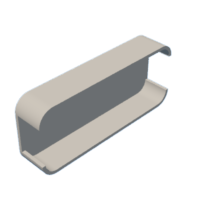Introduction: WLED ON XIAO ESP32
Hi, all
If you're not familiar with WLED, the WLED Project is a web server that controls LEDs and SPI-based chipsets. It can control two types of LED strips: digital addressable and analog non-addressable. WLED also provides open protocols to communicate with platforms like Amazon Alexa, Google Assistant, and Phillips Hue, it is based on both ESP controllers, and it is completely open-source. so let's look at how to install it in our tiny Xiao-ESP32-S3 from Seeed Studio i also bulled a encloser for it
Supplies
Step 1: Case for XIAO in Fusion 360
First of all, let's talk about how I made a case for Xiao in Fusion 360.
![]()
- Imported a 3d model of Xiao from Grabcad
- Sketched a square
- Extruded it to the required height
- Done Fillet on the 4 corners
- Used shell tool to convert it into a 1 mm thick wall
- Removed two sides one for the USB-C port and another for cables and antenna
- Made a cap of 1mm by utilizing the projection tool
- Extrude another 1mm from the cap and push the walls for the snap-fit of the cap
- Made an airway for Xiao on the cap by cutting with a sketch
Done !!
Step 2: 3d Printing
![]()
Used by Anycubic Kobra 2 neo for this with a Black PLA
Step 3: Flashing WLED to Xiao
![]()
Now let's flash the WLED to xiao esp32c3, connect the Xiao with USB
XIAO ESP32C3 is a low-cost, high-performance RISC-V IOT development board that supports Bluetooth and WiFi and low-power mode.
And go to wled-install.github.io
Select the board type to ESP32C3 (4MB Flash)
Click install
![]()
Select the COM port and click connect
![]()
Click Install on the next window that appears
The installation process will start
![]()
Now click next
![]()
Enter your local wifi SSID and Password
![]()
Now the WLED will content to our network and test this go-to-visit device
![]()
Now this open a wled web page interface
![]()
Step 4: Wiring

Participated in the
Anything Goes Contest












![Tim's Mechanical Spider Leg [LU9685-20CU]](https://content.instructables.com/FFB/5R4I/LVKZ6G6R/FFB5R4ILVKZ6G6R.png?auto=webp&crop=1.2%3A1&frame=1&width=306)


